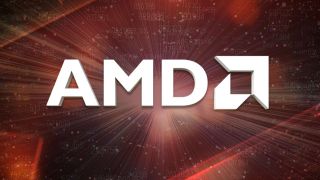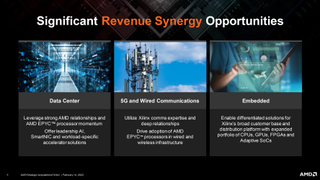AMD Closes Xilinx Deal: First Products Expected in 2023
When two become one.

AMD on Monday completed the acquisition of Xilinx, creating a company that can offer various types of compute devices, including CPUs, GPUs, and FPGAs. The move will help AMD to continue expanding its presence in the datacenter sector and offer unique solutions that will combine IP ingredients designed by the two companies. Interestingly, the first fruits of the deal are expected to materialize next year.
AMD CEO Dr. Lisa Su told analyst Patrick Moorhead that the first processor combining Xilinx technologies will arrive in 2023, which is in contrast to the company's previous integration efforts. After AMD bought ATI Technologies in 2006, it took the company five years to build its first accelerated processing units (which included AMD's x86 cores and ATI's GPU). This time AMD inked a long-term development pact with Xilinx and was able to work collaboratively even before the regulators approved the transaction. It remains to be seen what exactly AMD plans to offer, but it is reasonable to expect the new processor to feature AMD's x86 cores and Xilinx's programmable engines.

The merger between AMD and Xilinx is one of the cases when the combined company represents more than the sum of its parts. AMD sells CPUs for client PCs and servers, graphics processors for client PCs and HPC/datacenters, semi-custom system-on-chips for game consoles, and semi-custom SoCs for embedded applications in the automotive and entertainment industries. AMD's products rarely overlap with those from Xilinx, which are used in aerospace, analytics, AI inference, automotive, communications, datacenter, HPC, industrial, and many other verticals.
There are certain industries when AMD's high-performance CPUs or GPUs compete against Xilinx's FPGAs or special-purpose ASICs, but in most cases, AMD's CPUs and Xilinx chips/software can complement each other in one system. Now that AMD can offer CPUs, GPUs, FPGAs, and adaptive SoCs, its commercial platforms can become significantly more competitive.

"The acquisition of Xilinx brings together a highly complementary set of products, customers and markets combined with differentiated IP and world-class talent to create the industry's high-performance and adaptive computing leader," said Lisa Su, chief executive of AMD. "Xilinx offers industry-leading FPGAs, adaptive SoCs, AI inference engines and software expertise that enable AMD to offer the strongest portfolio of high-performance and adaptive computing solutions in the industry and capture a larger share of the approximately $135 billion market opportunity we see across cloud, edge, and intelligent devices."
Of course, it will take time to integrate Xilinx into AMD and build platform offerings comprising both companies' hardware. But even the journey of a thousand miles begins with the first step, which is what the two companies formally start today. Surprisingly, the two companies expect quite rapid progress in developing products encompassing IP from AMD and Xilinx, which is a result of collaborative work that spanned for well over a year. Meanwhile, AMD's and Xilinx's roadmaps will not be affected by the transaction, so all the products previously announced in one way or another will be developed and will come to market.

The Xilinx business will become AMD's Adaptive and Embedded Computing Group (AECG), led by former Xilinx CEO Victor Peng. As a result, Xilinx will maintain its leadership for at least a while. Furthermore, AMD's embedded business will cease to be a part of the company's enterprise and semi-custom unit and will merge into AECG, which might be good news as executives from the enterprise division will now spend more time on EPYC CPUs.
Stay on the Cutting Edge
Join the experts who read Tom's Hardware for the inside track on enthusiast PC tech news — and have for over 25 years. We'll send breaking news and in-depth reviews of CPUs, GPUs, AI, maker hardware and more straight to your inbox.

Anton Shilov is a Freelance News Writer at Tom’s Hardware US. Over the past couple of decades, he has covered everything from CPUs and GPUs to supercomputers and from modern process technologies and latest fab tools to high-tech industry trends.
Most Popular







